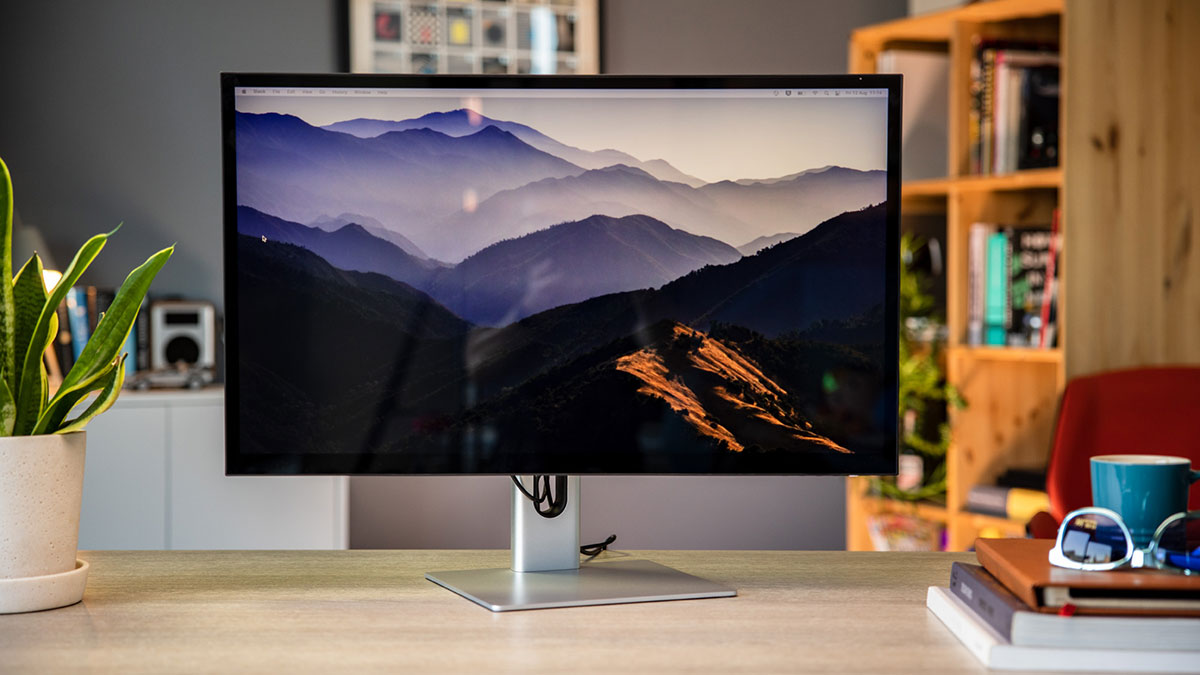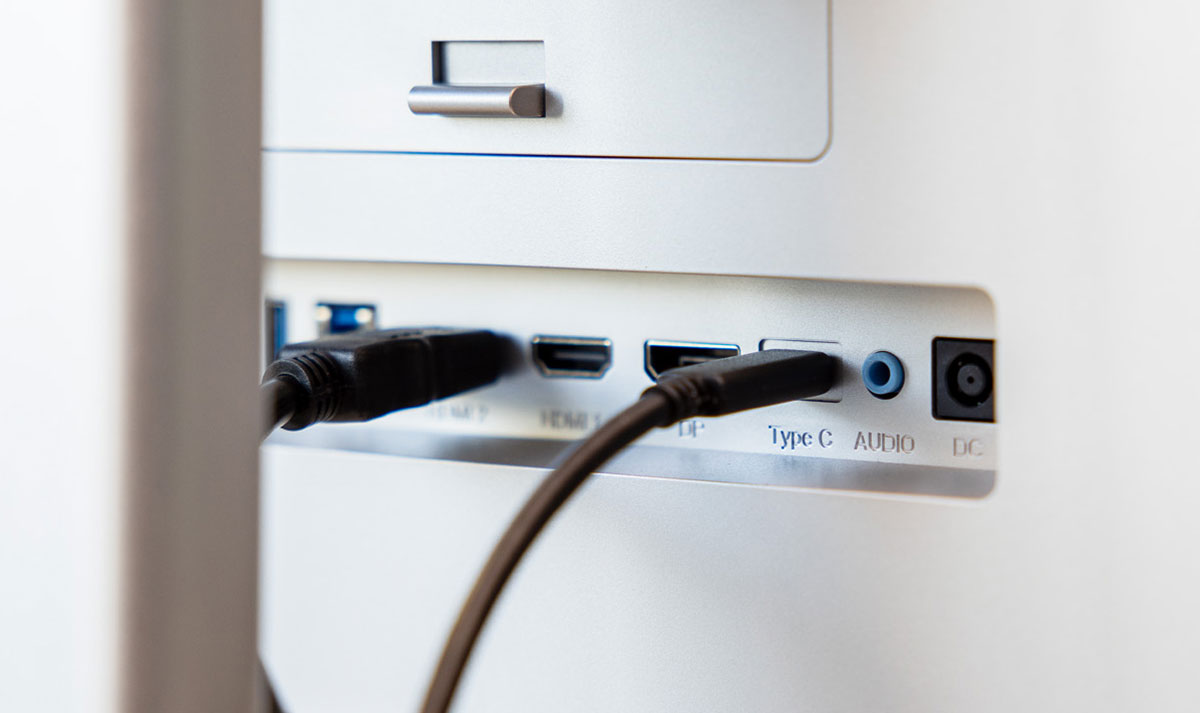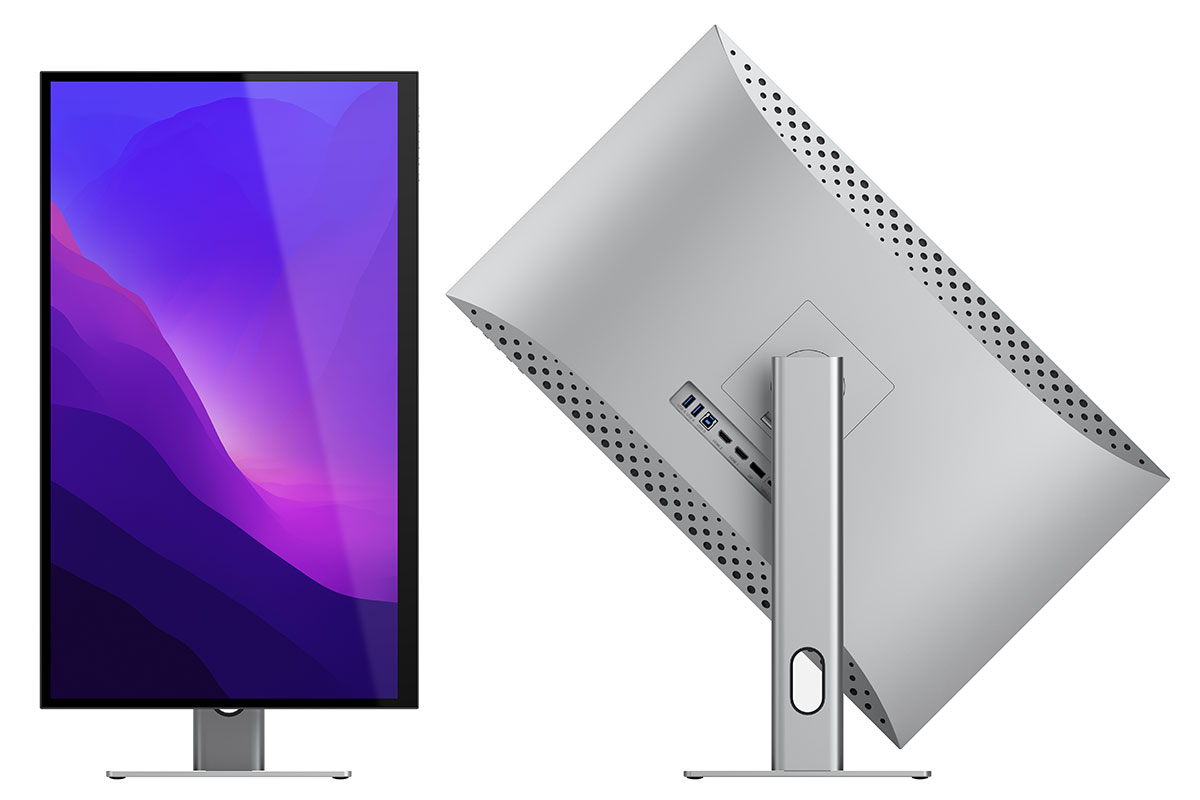 At a glance
At a glanceExpert’s Rating
Pros
- Impressive 4K 60Hz screen
- Fantastic adjustable stand
- Built-in USB hub
Cons
- 4K not 5K
- USB-C rather than Thunderbolt connection
- Hub doesn’t daisy-chain extra displays
Our Verdict
The Alogic Clarity is a stunning looking 27in display with built-in hub and a fantastic height-adjustable, tilt and pivot stand. It will appeal to Mac users with its Apple looks and is even, in some ways, a superior monitor to Apple’s own Studio Display, although its 4K resolution isn’t quite as sharp as Apple’s 5K screen.
Price When Reviewed
$799.99
Best Prices Today: Alogic Clarity 27in UHD 4K Monitor
Boasting the looks of an Apple display but at a more affordable price, the Alogic Clarity Monitor scores points on aesthetics and performance. Connected to a Mac mini or Mac Studio, this 27-inch display could recreate the glories of the now discontinued larger iMac.
Apple sells two of its own displays, and, as you might expect, neither of them is particularly affordable. The high-end Pro Display XDR from costs $4,999 and the “entry-level” Studio Display costs from $1,599. Read our Apple Studio Display review.
There are, of course, plenty of non-Apple displays available. At $650, the Dell 2720Q UltraSharp 27in 4K USB-C Monitor is less than half the price of the Apple monitor. Its 4K (3,840by-2,160) screen is not up to the Studio Display’s 5K resolution but will suit most users.
But, as fine a display as that is, a Dell or HP monitor still looks like a Dell or HP monitor, and Apple users crave Ive-like aesthetics on their desktop.
There’s a new screen from Alogic that significantly undercuts the Apple Studio Display on price and mimics Apple’s looks so Mac users don’t suffer the indignity of having Dell written over the back of their display.
 https://b2c-contenthub.com/wp-content/uploads/2022/08/Alogic-Clarity-27in-Monitor-Front.jpg?resize=300%2C168&quality=50&strip=all 300w, https://b2c-contenthub.com/wp-content/uploads/2022/08/Alogic-Clarity-27in-Monitor-Front.jpg?resize=768%2C432&quality=50&strip=all 768w, https://b2c-contenthub.com/wp-content/uploads/2022/08/Alogic-Clarity-27in-Monitor-Front.jpg?resize=150%2C84&quality=50&strip=all 150w" width="1024" height="576" sizes="(max-width: 1024px) 100vw, 1024px" />
https://b2c-contenthub.com/wp-content/uploads/2022/08/Alogic-Clarity-27in-Monitor-Front.jpg?resize=300%2C168&quality=50&strip=all 300w, https://b2c-contenthub.com/wp-content/uploads/2022/08/Alogic-Clarity-27in-Monitor-Front.jpg?resize=768%2C432&quality=50&strip=all 768w, https://b2c-contenthub.com/wp-content/uploads/2022/08/Alogic-Clarity-27in-Monitor-Front.jpg?resize=150%2C84&quality=50&strip=all 150w" width="1024" height="576" sizes="(max-width: 1024px) 100vw, 1024px" />IDG
Screen pixels and colors
As with the Dell, the Alogic Clarity offers a 4K (3,840-x-2,160 pixels) screen, capable of displaying over a billion colors, and having a 60Hz refresh rate.
5K displays offer more pixels than 4K: 14,745,000 pixels vs 9,437,184. That’s enough to show a 4K video and have space over for other tools. The more pixels, the smoother the lines and sharper the images.
But you can save a lot of money with one 4K or even have two 4K displays for the price of a 5K monitor.
The Clarity’s 4K Ultra High Definition screen (163 pixels per inch) doesn’t offer the pixel density of a 5K display such as the Studio Display (218 pixels per inch) so might have less appeal to graphics and video professionals, but it’s still over four times as impressive as a High Definition (HD) screen (82 pixels per inch).
For twice the price of the Clarity, Apple’s Studio Display can go brighter (600 nits vs 400) but Alogic’s display supports HDR (High Dynamic Range) 600 content, which means that the whites of the display are very bright and clear, and the blacks much deeper, giving the same effect as 600 nits. Apple’s Studio Display lacks HDR.
While both displays use TFT LCD technology with LED backlights, the Clarity uses QLED (Quantum Dot LED) technology that helps produce brighter and more vibrant colors than usual.
Clarity incorporates In-Plane Switching (IPS) display panel technology that enables workplace teams to view the same screen from angles up to 178 degrees with minimal diminishment of image quality.
There’s no doubt that the Studio Display offers a higher-end screen, but the Alogic Clarity’s high-quality screen is bright and impressive enough for most users.
 https://b2c-contenthub.com/wp-content/uploads/2022/08/Alogic-Clarity-Monitor-Ports-Hub.jpg?resize=300%2C168&quality=50&strip=all 300w, https://b2c-contenthub.com/wp-content/uploads/2022/08/Alogic-Clarity-Monitor-Ports-Hub.jpg?resize=768%2C432&quality=50&strip=all 768w, https://b2c-contenthub.com/wp-content/uploads/2022/08/Alogic-Clarity-Monitor-Ports-Hub.jpg?resize=150%2C84&quality=50&strip=all 150w" width="1024" height="576" sizes="(max-width: 1024px) 100vw, 1024px" />
https://b2c-contenthub.com/wp-content/uploads/2022/08/Alogic-Clarity-Monitor-Ports-Hub.jpg?resize=300%2C168&quality=50&strip=all 300w, https://b2c-contenthub.com/wp-content/uploads/2022/08/Alogic-Clarity-Monitor-Ports-Hub.jpg?resize=768%2C432&quality=50&strip=all 768w, https://b2c-contenthub.com/wp-content/uploads/2022/08/Alogic-Clarity-Monitor-Ports-Hub.jpg?resize=150%2C84&quality=50&strip=all 150w" width="1024" height="576" sizes="(max-width: 1024px) 100vw, 1024px" />Alogic
Built-in multi-port hub
Like the best USB-C displays, both Apple’s Studio Display and the Alogic Clarity offer more than just an screen space for your computer.
The Clarity’s back-mounted hub includes a USB-C upstream port that supports DisplayPort 1.4, plus an upstream USB-B port, and two USB-A downstream ports, plus a DisplayPort 1.4 and two HDMI 2.0 ports.
You connect from your Mac to the screen for Extended or Mirrored display modes via either the USB-C, DisplayPort 1.4 or one of the HDMI 2.0 ports.
Using USB-C or USB-B, it can connect to your computer for not just the display but also charge a laptop at up to 90W at the same time.
The monitor’s overall power supply is 180W, so you can use the full 90W on a laptop and the remainder for other devices via the USB ports.
This means that you don’t need a separate power supply for your laptop. You can just connect with one cable to get an external display and keep even a 16in laptop fully charged.
Apple’s Studio Display offer a little more power but nothing significantly better. Its connectivity hub appears sparser, with one upstream 96W PD Thunderbolt 3 port to connect to the computer and three 10Gbps USB-C ports for connecting peripherals and storage devices.
The Clarity’s two USB-A ports can be used to attach USB peripherals such as a keyboard, mouse or webcam to the computer. Obviously, for the computer to see any attached devices, it must be connected to either the USB-C or USB-B port.
If the computer is connected to the USB-C port on the display the USB-A ports will operate at a rather lame USB 2.0 (480MBps) speed because the video traffic shares the USB-C cable with the USB data—this is where the Studio Display’s higher-bandwidth 40Gbps Thunderbolt 3 connection and fast USB-C ports easily win out. USB 2.0 is sufficient for most peripherals (keyboards, mice and webcam, etc) but not for high-speed storage devices such as external hard drives and USB flash drives.
However, if the computer is connected to the display’s USB-B port, the USB-A ports will operate at 5Gbps USB 3.0 speed.
 https://b2c-contenthub.com/wp-content/uploads/2022/08/Alogic-Clarity-ports-hub-closeup.jpg?resize=300%2C178&quality=50&strip=all 300w, https://b2c-contenthub.com/wp-content/uploads/2022/08/Alogic-Clarity-ports-hub-closeup.jpg?resize=768%2C456&quality=50&strip=all 768w" width="1024" height="608" sizes="(max-width: 1024px) 100vw, 1024px" />
https://b2c-contenthub.com/wp-content/uploads/2022/08/Alogic-Clarity-ports-hub-closeup.jpg?resize=300%2C178&quality=50&strip=all 300w, https://b2c-contenthub.com/wp-content/uploads/2022/08/Alogic-Clarity-ports-hub-closeup.jpg?resize=768%2C456&quality=50&strip=all 768w" width="1024" height="608" sizes="(max-width: 1024px) 100vw, 1024px" />IDG
The Clarity monitor comes with three cables: USB-C to USB-C, HDMI to HDMI and USB-A to USB-B. Therefore, to connect your Mac to the screen and make the most of the hub’s USB-A ports you will need an extra USB-C to USB-B cable, which isn’t included but are inexpensive.
The Apple Studio Display comes with one 1m Thunderbolt cable.
While the Apple display’s hub looks less full than the Clarity’s, its use of Thunderbolt and 10Gbps USB-C is more flexible than the Clarity’s hub. This includes two HDMI and one DisplayPort but only one of these can be used at one time.
Despite the multiple display connections you cannot, for now at least, daisy chain other displays to the Clarity’s hub. Alogic says that daisy-chaining functionality is “included in the future upgrade road map”, which would make sense given it has two HDMI ports.
The best setup for the Clarity monitor is vis USB-B (requiring an extra cable), leaving the USB-C and USB-A ports free for 5Gbps connections.
 https://b2c-contenthub.com/wp-content/uploads/2022/08/Alogic-Clarity-4K-Display-Side-View-1.jpg?resize=300%2C168&quality=50&strip=all 300w, https://b2c-contenthub.com/wp-content/uploads/2022/08/Alogic-Clarity-4K-Display-Side-View-1.jpg?resize=768%2C432&quality=50&strip=all 768w, https://b2c-contenthub.com/wp-content/uploads/2022/08/Alogic-Clarity-4K-Display-Side-View-1.jpg?resize=1200%2C675&quality=50&strip=all 1200w, https://b2c-contenthub.com/wp-content/uploads/2022/08/Alogic-Clarity-4K-Display-Side-View-1.jpg?resize=1240%2C697&quality=50&strip=all 1240w, https://b2c-contenthub.com/wp-content/uploads/2022/08/Alogic-Clarity-4K-Display-Side-View-1.jpg?resize=150%2C84&quality=50&strip=all 150w" width="1200" height="675" sizes="(max-width: 1200px) 100vw, 1200px" />
https://b2c-contenthub.com/wp-content/uploads/2022/08/Alogic-Clarity-4K-Display-Side-View-1.jpg?resize=300%2C168&quality=50&strip=all 300w, https://b2c-contenthub.com/wp-content/uploads/2022/08/Alogic-Clarity-4K-Display-Side-View-1.jpg?resize=768%2C432&quality=50&strip=all 768w, https://b2c-contenthub.com/wp-content/uploads/2022/08/Alogic-Clarity-4K-Display-Side-View-1.jpg?resize=1200%2C675&quality=50&strip=all 1200w, https://b2c-contenthub.com/wp-content/uploads/2022/08/Alogic-Clarity-4K-Display-Side-View-1.jpg?resize=1240%2C697&quality=50&strip=all 1240w, https://b2c-contenthub.com/wp-content/uploads/2022/08/Alogic-Clarity-4K-Display-Side-View-1.jpg?resize=150%2C84&quality=50&strip=all 150w" width="1200" height="675" sizes="(max-width: 1200px) 100vw, 1200px" />IDG
Design and looks
Alogic is targeting Mac users so follows Apple’s sleek display design cues. The Clarity display won’t look out of place next to a Mac, whether it’s a Mac mini, Mac Studio or MacBook.
It’s two inches deeper than the slim Apple monitor, but its old-iMac-like curved back means you won’t notice from the front. It’s also taller because of its handy adjustable height.
The Clarity measures 56.5cm tall (22.2in), 62.4cm (24.5in) wide and 22cm (8.7in) deep. It weighs 7.5kg.
The Studio Display measures 47.8cm tall (18.8in), 62.3cm (24.5in) wide and 16.8cm (6.6in) deep. It weighs 6.3kg.
 https://b2c-contenthub.com/wp-content/uploads/2022/08/Alogic-Clarity-Monitor-Vertical-Orientation.jpg?resize=300%2C200&quality=50&strip=all 300w, https://b2c-contenthub.com/wp-content/uploads/2022/08/Alogic-Clarity-Monitor-Vertical-Orientation.jpg?resize=768%2C512&quality=50&strip=all 768w, https://b2c-contenthub.com/wp-content/uploads/2022/08/Alogic-Clarity-Monitor-Vertical-Orientation.jpg?resize=150%2C100&quality=50&strip=all 150w" width="1024" height="683" sizes="(max-width: 1024px) 100vw, 1024px" />
https://b2c-contenthub.com/wp-content/uploads/2022/08/Alogic-Clarity-Monitor-Vertical-Orientation.jpg?resize=300%2C200&quality=50&strip=all 300w, https://b2c-contenthub.com/wp-content/uploads/2022/08/Alogic-Clarity-Monitor-Vertical-Orientation.jpg?resize=768%2C512&quality=50&strip=all 768w, https://b2c-contenthub.com/wp-content/uploads/2022/08/Alogic-Clarity-Monitor-Vertical-Orientation.jpg?resize=150%2C100&quality=50&strip=all 150w" width="1024" height="683" sizes="(max-width: 1024px) 100vw, 1024px" />Alogic
One area where Alogic easily beats Apple is its excellent stand, which is height-adjustable (to 150mm), plus can tilt and swivel and rotate in portrait and landscape orientations. Cleverly, a gravity sensor detects the rotation and adjusts the picture to match the orientation.
Apple’s Studio Display simply can’t pivot to a portrait orientation, although its tilt is a little better than the Clarity: 30° to Alogic’s 25° tilt potential.
The Clarity screen has great lateral movement, too.
In comparison, if you want to adjust the height of the Apple Studio Display you’ll need to invest a hefty $400/£400 for the extra tilt- and height-adjustable stand, which can be adjusted 105mm.
 https://b2c-contenthub.com/wp-content/uploads/2022/08/Alogic-Clarity-height-adjustable-stand.jpg?resize=300%2C217&quality=50&strip=all 300w, https://b2c-contenthub.com/wp-content/uploads/2022/08/Alogic-Clarity-height-adjustable-stand.jpg?resize=768%2C556&quality=50&strip=all 768w" width="1000" height="724" sizes="(max-width: 1000px) 100vw, 1000px" />
https://b2c-contenthub.com/wp-content/uploads/2022/08/Alogic-Clarity-height-adjustable-stand.jpg?resize=300%2C217&quality=50&strip=all 300w, https://b2c-contenthub.com/wp-content/uploads/2022/08/Alogic-Clarity-height-adjustable-stand.jpg?resize=768%2C556&quality=50&strip=all 768w" width="1000" height="724" sizes="(max-width: 1000px) 100vw, 1000px" />Alogic
Without, ahem, raising the Studio Display price to $1,999/£1,899, what you get from Apple doesn’t score well on ergonomic points. I had to raise my 27in iMac for a healthier view—using Satechi’s Aluminum Monitor Stand—and the Studio Display is actually lower than the iMac.
More shocking still, the two Apple stands aren’t user replaceable, so you can’t decide later to just buy the extra height-adjustable stand if the standard one doesn’t reach a comfortable height for you. You’ll need to get an Apple-certified engineer to swap out the stands.
The Clarity stand, on the other hand, is simple to snap together to the screen, with no screws necessary.
Both monitors can be attached to a VESA arm. Apple requires you to buy its own at the expense of the default stand.
There’s no on\off switch on the Studio Display where everything is controlled through the Mac, while the Clarity can be turned on and off and settings and speaker-volume adjusted with under screen buttons—making it a better choice for Windows PCs, which might be important in a mixed-platform environment.
Audio and video
The Apple Studio Display features a 12-megapixel webcam, although there have been complaints about degraded quality. While Clarity doesn’t include a built-in webcam, you can connect a superior one using one of the USB ports. Alogic even has one of its own, the 1080p HD Iris USB Webcam A09, which has both a USB-A and USB-C connection. Used with the Clarity display, you’ll likely use the USB-A connection unless you are connecting your laptop to the display using the DisplayPort/HDI connections.
Apple also includes built-in microphones to support voice and video calls.
Audio is noticeably superior on the Studio Display, which features a six-speaker system with force-cancelling woofers, wide stereo sound, and support for Spatial Audio for Dolby Atmos content. However, Apple acknowledges that it requires a software update to fix various problems.
Alogic has equipped its Clarity display with two 5W speakers. The built-in headphone jack could be used to connect external speakers.
 https://b2c-contenthub.com/wp-content/uploads/2022/08/Alogic-Clarity-Mac-Studio.jpg?resize=300%2C185&quality=50&strip=all 300w, https://b2c-contenthub.com/wp-content/uploads/2022/08/Alogic-Clarity-Mac-Studio.jpg?resize=768%2C473&quality=50&strip=all 768w" width="1024" height="631" sizes="(max-width: 1024px) 100vw, 1024px" />
https://b2c-contenthub.com/wp-content/uploads/2022/08/Alogic-Clarity-Mac-Studio.jpg?resize=300%2C185&quality=50&strip=all 300w, https://b2c-contenthub.com/wp-content/uploads/2022/08/Alogic-Clarity-Mac-Studio.jpg?resize=768%2C473&quality=50&strip=all 768w" width="1024" height="631" sizes="(max-width: 1024px) 100vw, 1024px" />Alogic
Make your own 27-inch iMac
Apple decided to discontinue its classic 27-inch iMac, leaving just the 24-inch iMac as an all-in-one desktop. If the 24-inch iMac is just too small a screen for you, you’ll need to buy a screenless Mac desktop and an external display.
Apple would prefer you to buy a Mac mini or Mac Studio and one of its super Studio Display screens, but this option comes with a hefty price tag.
The Mac mini starts at $699/£699 and the 27-inch Studio Display from $1,599/£1,499. If you want to adjust the height of the Studio Display, it’s another $400/£400, although that wasn’t possible with the iMac either unless you used a monitor stand.
So today there’s a minimum $2,298 cost to recreate what was once a $1,799 iMac, with 256GB hard drive.
The Apples for Apples specs are quite similar. The 27-inch iMac came with a 5K Retina Display with 5120-by-2880 resolution, as does the Studio Display.
Using a 256GB Mac mini and the Alogic Clarity would cost just $1,498 in comparison—an $800 saving for the loss of the 5K display’s extra pixels.
Price
For a quality 27in display, Alogic’s Clarity is competitively priced at $799.99, £700, CA$799.99 or AU$899.
It’s tough not to gulp when comparing that to Apple’s $1,599, £1,499, CA$1,999 and AU$2,499 price tags for its Studio Display.
If you want the equivalent of a 27in iMac, you could build a great pairing of an M1 Mac mini and Clarity display from $1,500 (8GB RAM and 256GB SSD) or better $2,100 (16GB RAM and 1TB SSD). Or upgrade to a much-superior M1 Max Mac Studio and Clarity display from $3,000 (32GB RAM and 1TB SSD).
As detailed above, to do the same using Apple’s Studio Display would add $800 to the whole setup, and we’d still advise you to consider the extra $400 cost of the height-adjustable stand.
For our round up of the best displays for Macs read: Best Mac monitors and displays.






